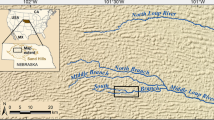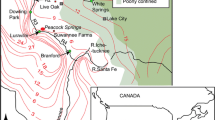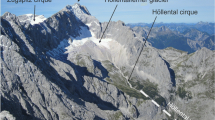Abstract
Previous watershed assessments have relied on annual baseflow to evaluate the groundwater contribution to streams. To quantify the volume of groundwater in storage, additional information such as groundwater mean transit time (MTT) is needed. This study determined the groundwater MTT in the West Fork Duchesne watershed in Utah (USA) with lumped-parameter modeling of environmental tracers (SF6, CFCs, and 3H/3He) from 21 springs. Approximately 30% of the springs exhibited an exponential transit time distribution (TTD); the remaining ~70% were best characterized by a piston-flow TTD. The flow-weighted groundwater MTT for the West Fork watershed is about 40 years with approximately 20 years in the unsaturated zone. A cumulative distribution of these ages revealed that most of the groundwater is between 30 and 50 years old, suggesting that declining recharge associated with 5–10-year droughts is less likely to have a profound effect on this watershed compared with systems with shorter MTTs. The estimated annual baseflow of West Fork stream flow based on chemical hydrograph separation is ~1.7 × 107 m3/year, a proxy for groundwater discharge. Using both MTT and groundwater discharge, the volume of mobile groundwater stored in the watershed was calculated to be ~6.5 × 108 m3, or ~20 m thickness of active groundwater storage and recharge of ~0.09 m/year (assuming porosity = 15%). Future watershed-scale assessments should evaluate groundwater MTT, in addition to annual baseflow, to quantify groundwater storage and more accurately assess watershed susceptibility to drought, groundwater extraction, and land-use change.
Résumé
Les estimations préalables de bassin versant ont été reliées au débit de base pour évaluer la participation de l’eau souterraine aux cours d’eau superficiels. Afin de quantifier le volume d’eau souterraine stockée, des informations supplémentaires, tel. le temps de transit moyen (TTM) des eaux souterraines sont nécessaires. Cette étude a déterminé le TTM des eaux souterraines dans le bassin versant de la West Fork Duchesne dans l’Utah (USA) à partir d’une modélisation à paramètres localisés des traceurs environnementaux (SF6, CFCs et 3H/3He) mesurés à 21 sources. Approximativement 30% des sources présentent une distribution des temps de transit exponentielle (DTT); les 70% restants sont mieux caractérisées par un modèle piston DTTD. Le TTM des eaux souterraines du bassin de la West Fork, pondéré par les débits, est. d’environ 40 ans avec approximativement 20 ans dans la zone non saturée. Une distribution cumulative de ces âges a révélé que la majeure partie des eaux souterraines est. âgée entre 30 et 50 ans, suggérant que la diminution de recharge associé aux 5 à 10 ans de sécheresse a probablement moins d’impact sur le bassin versant que sur des systèmes à plus faibles TTMs. Le débit de base annuel estimé de la rivière West Fork, basé sur une séparation chimique de l’hydrogramme de crue est. de ~1.7 × 107 m3/an, un indicateur de l’apport des eaux souterraines. En utilisant à la fois le TTM et l’apport des eaux souterraines, le volume d’eau gravitaire stocké dans le bassin versant a été calculé égal à ~6.5 × 108 m3, soit ~20 m d’épaisseur de stockage actif d’eau souterraines et une recharge de ~0.09 m/an (en supposant une porosité de 15%).Les futures estimations de tailles de bassin versant devraient évaluer le TTM, en plus du débit de base annuel, pour quantifier le stockage d’eau souterraine et apprécier plus précisément la sensibilité du bassin versant à la sécheresse, l’extraction d’eau souterraine et le changement d’occupation des sols.
Resumen
Las evaluaciones previas de las cuencas hidrográficas se han basado en el flujo de base anual para evaluar la contribución del agua subterránea a las corrientes de agua. Para cuantificar el volumen de agua subterránea almacenada, se necesita información adicional como el tiempo medio de transporte (MTT) del agua subterránea. Este estudio determinó el MTT del agua subterránea en la cuenca de West Fork Duchesne en Utah (EEUU, con el modelado de parámetros ambientales de trazadores ambientales (SF6, CFCs, and 3H/3He) de 21 manantiales. Aproximadamente el 30% de los manantiales exhibieron una distribución exponencial del tiempo de tránsito (TTD); El ~70% restante se caracterizó mejor por un TTD de flujo pistón. El MTT del agua subterránea ponderado por flujo para la cuenca de West Fork es de aproximadamente 40 años con alrededor de 20 años en la zona no saturada. Una distribución acumulativa de estas edades reveló que la mayor parte del agua subterránea tiene entre 30 y 50 años de edad, lo que sugiere que la disminución de la recarga asociada con sequías de 5–10 años es menos probable que tenga un efecto profundo en esta cuenca en comparación con sistemas con MTTs más cortos. El flujo de base anual estimado del flujo de la corriente de West Fork basado en la separación del hidrograma químico es ~1.7 × 107 m3/ año - un indicador para la descarga de agua subterránea. Se calculó que el volumen de agua subterránea en movimiento almacenada en la cuenca fue de ~6.5 × 108 m3, o ~20 m de almacenamiento activo de agua subterránea y recarga de ~0.09 m año (suponiendo una porosidad = 15%). Las futuras evaluaciones a escala de cuenca deberían evaluar el MTT del s agua subterránea, además del flujo base anual, para cuantificar el almacenamiento de agua subterránea y evaluar con mayor precisión la susceptibilidad a la sequía, la extracción del agua subterránea y el cambio en el uso de la tierra.
摘要
过去的流域评价依赖于每年的基流来评估地下水流入河流的量。为了量化储存的地下水数量,需要额外的信息诸如地下水平均经过时间。利用21个泉环境示踪剂(SF6, CFCs 和 3H/3He)集中参数模拟,本研究确定了(美国)犹他州West Fork Duchesne流域的地下水平均经过时间。大约30%的泉展示出了指数经过时间分布;剩下的大约70%的泉最大的特征就是活塞流经过时间分布。West Fork流域水流加权的地下水平均经过时间大约为40年,其中大约20年在非饱和带。这些年龄的累积分布揭示,大多数地下水的年龄为30到50年,表明,与具有更短的平均经过时间的系统相比,和5–10年干旱相关联的补给量下降对本流域的影响较小。基于化学分离自记水位计的West Fork河流量为大约1.7 × 107 m3/年--等于地下水排泄量。采用平均经过时间和地下水排泄量,计算了储存在流域内的流动地下水量,大约为6.5 × 108 m3,或者相当于大约20 m 厚的活跃地下水储存量,补给量大约为 ~0.09 m/年(假定孔隙度 = 15%)。未来流域尺度的评价应当评估地下水平均经过时间,加上每年的基流量,来量化地下水储存量,更精确地评价流域对干旱、抽取地下水和土地利用变化的敏感性。
Resumo
Avaliações anteriores de bacias hidrográficas basearam-se no fluxo de base anual para avaliar a contribuição das águas subterrâneas para canais de drenagem. Para quantificar o volume de água subterrânea armazenada, é necessária informação adicional tal como o tempo médio de transito (TMT) das águas subterrâneas. Este estudo determinou o TMT das águas subterrâneas na bacia de West Fork Duchesne em Utah (EUA) com modelagem de parâmetros concentrados por traçadores ambientais (SF6, CFCs e 3H/3He) de 21 nascentes. Aproximadamente 30% das nascentes demonstraram uma distribuição do tempo de transito (DTT) exponencial; as restantes ~70% foram melhor caracterizadas por DTT de fluxo de pistão. O TMT ponderado do fluxo das águas subterrâneas para a bacia West Fork é cerca de 40 anos com aproximadamente 20 anos na zona não-saturada. Uma distribuição cumulativa dessas idades revelou que a maioria das águas subterrâneas tem entre 30 e 50 anos, sugerindo que a recarga em declínio associada a secas de 5–10 anos é menos provável que tenha um efeito intenso nesta bacia em comparação com sistemas com TMT mais curtos. O fluxo de base anual estimado de West Folk com base na separação química de hidrógrafas é de ~1.7 × 107 m3/ano, uma representação para a descarga das águas subterrâneas. Utilizando o TMT e a descarga de água subterrânea, o volume móvel de água subterrânea armazenada na bacia foi calculado para ser ~6.5 × 108 m3, ou ~20 m de espessura do estoque de água ativo e recarga de ~0.09 m/ano (assumindo porosidade = 15%). Futuras avaliações em escala de bacia hidrográfica poderão avaliar o TMT das águas subterrâneas, além do fluxo de base anual, para quantificar o armazenamento de água e avaliar com maior precisão a suscetibilidade da baca hidrográfica à seca, extração de águas subterrâneas e mudança no uso da terra.






Similar content being viewed by others
References
Aeschbach-Hertig W, Solomon DK (2013) Noble gas thermometry in groundwater hydrology. In: Burnard P (ed) The noble gases as geochemical tracers. Springer, Heidelberg, Germany, pp 81–122
Ashland FX, Bishop CE, Lowe M, Mayes BH (2001) The geology of the Synderville Basin, western Summit County, Utah, and its relation to groundwater conditions. Utah Geol Surv Open-File Rep 337, Utah Department of Natural Resources Water Resources, Salt Lake City, UT, 59 pp
Böhlke JK (2002a) Groundwater recharge and agricultural contamination. Hydrogeol J 10(1):153–179
Böhlke JK (2002b) Groundwater recharge and agricultural contamination: erratum. Hydrogeol J 10(1):438–439
Böhlke JK (2006) TRACERMODEL1: Excel workbook for calculation and presentation of environmental tracer data for simple groundwater mixtures, part 10.3. In: International Atomic Energy Agency (ed) Use of chlorofluorocarbons in hydrology: a guidebook. IAEA, Vienna, pp 239–246. Available online at URL http://www-pub.iaea.org/MTCD/Publications/PDF/Pub1238_web.pdf. Accessed 1 June 2017
Böhlke JK, Denver JM (1995) Combined use of groundwater dating, chemical, and isotopic analyses to resolve the history and fate of nitrate contamination in two agricultural watersheds, Atlantic coastal plain, Maryland. Water Resour Res 31(9):2319–2339
Böhlke JK, Krantz DE (2003) Isotope geochemistry and chronology of offshore ground water beneath Indian River Bay, Delaware. US Geol Surv Water Resour Invest Rep 03-4192, 37 pp. Available online at http://pubs.water.usgs.gov/wri03-4192. Accessed 1 June 2017
Brown CJ, JJ Starn, KG Stollenwerk, RA Mondazzi, Trombley TJ (2009) Aquifer chemistry and transport processes in the zone of contribution to a public-supply well in Woodbury, Connecticut, 2002–06. US Geol Surv Sci Invest Rep 2009-5051, 158 pp
Bryant B (2010) Geologic map of the east half of the Salt Lake City 1° × 2° quadrangle (Duchesne and Kings Peak 30′ × 60′ quadrangles), Duchesne, Summit, and Wasatch counties, Utah, and Uinta County, Wyoming. US Geol Surv Miscell Invest Series Map I-1997, 1992, Miscell. Publ. 10-1DM, scale 1:125,000, 3 sheets
Busenberg E, Plummer LN (1992) Use of chlorofluorocarbons (CCl 3 F and CCl 2 F 2 ) as hydrologic tracers and age-dating tools: the alluvium and terrace system of central Oklahoma. Water Resour Res 28:2257–2283
Constenius KN, DL Clark, JK King, Ehler JB (2011) Interim geologic map of the Provo 30′ × 60′ quadrangle, Utah, Wasatch and Salt Lake counties, Utah. Utah Geol Survey Open-File Rep 586DM, scale 1:62,500
Cook PG, Böhlke JK (2000) Determining timescales for groundwater flow and solute transport. In: Cook PG, Herczeg AL (eds) Environmental tracers in subsurface hydrology. Kluwer, Norwell, UK, pp 1–30
Cook PG, Solomon DK (1995) Transport of atmospheric trace gases to the water table: implications for groundwater dating with chlorofluorocarbons and krypton 85. Water Resour Res 31:263–270
Cook PG, Solomon DK (1997) Recent advances in dating young groundwater: chlorofluorocarbons, 3H/3He and 85Kr. J Hydrol 191:245–265. doi:10.1016/S0022-1694(96)03051-X
Cook PG, Favreau G, Dighton JC, Tickell S (2003) Determining natural groundwater influx to a tropical river using radon, chlorofluorocarbons and ionic environmental tracers: J Hydrol 227:74–88. doi:10.1016/S0022-1694(03)00087-8
CUWCD (2015) Vat diversion dam operation, central Utah project, diversion records March 2013–March 2014. Central Utah Water Conservancy District, Orem UT
Focazio MJ, Plummer LN, Böhlke JK, Busenberg E, Bachman LJ, Powers DS (1998) Preliminary estimates of residence times and apparent ages of ground water in the Chesapeake Bay watershed, and water-quality data from a survey of springs. US Geol Surv Water Resour Invest Rep 97-4225, 75 pp
Freethey GW, Cordy GE (1991) Geohydrology of the Mesozoic rocks in the upper Colorado River basin in Arizona. US Geol Surv Prof Pap 1411-C, 130 pp
Freeze RA, Cherry JA (1979) Groundwater. Prentice-Hall, Englewood Cliffs, NJ, 604 pp
Frisbee MD, Phillips FM, Campbell AR, Liu L, Sanchez SA (2011) Streamflow generation in a large, alpine watershed in the southern Rocky Mountains of Colorado: is streamflow generation simply the aggregation of hillslope runoff responses? Water Resour Res 47:1–18. doi:10.1029/2010WR009391
Genereux DP, Hemond HF (1990) Naturally occurring radon 222 as a tracer for streamflow generation: steady state methodology and field example. Water Resour Res 26(12):3065–3075. doi:10.1029/WR026i012p03065
Gilmore TE, Genereux DP, Solomon DK, Solder JE (2016) Groundwater transit time distribution and mean from streambed sampling in an agricultural coastal plain watershed, North Carolina, USA. Water Resour Res 52:2025–2044. doi:10.1002/ 2015WR017600
Jurgens BC, Burow KR, Dalgish BA, Shelton JL (2008) Hydrogeology, water chemistry, and factors affecting the transport of contaminants in the zone of contribution of a public-supply well in Modesto, eastern San Joaquin Valley, California. US Geol Surv Sci Invest Rep 2008-5156, 78 pp
Jurgens BC, Böhlke JK, Eberts SM (2012) TracerLPM (version 1): an Excel® workbook for interpreting groundwater age distributions from environmental tracer data. US Geol Surv Tech Methods Rep 4-F3, 60 pp
Katz BG, Hornsby HD, Böhlke JK, Mokray MF (1999) Sources and chronology of nitrate contamination in spring waters, Suwanee River basin, Florida. US Geol Surv Water Resour Invest Rep 99-4252, 54 pp
Katz BG, Böhlke JK, Hornsby HD (2001) Timescales for nitrate contamination of spring waters, northern Florida, USA. Chem Geol 179:167–186. doi:10.1016/S0009-2541(01)00321-7. Accessed 1 June 2017
Katz BG, McBride WS, Hunt AG, Crandall CA, Metz PA, Eberts SM, Berndt MP (2008) Vulnerability of a public supply well in a karstic aquifer to contamination. Ground Water 47(3):438–452
Kinzelbach W, Aeschbach W, Alberich C, Goni IB, Beyerle U, Brunner P, Chiang W-H, Rueedi J, Zoellmann K (2002) A survey of methods for groundwater recharge in arid and semiarid regions: early warning and assessment report series: Nairobi. Division of Early Warning and Assessment, United Nations Environment Programme, Nairobi, Kenya, 101 pp
Kirchner JW, Feng X, Neal C (2000) Fractal stream chemistry and its implications for contaminant transport in catchments. Nature 403(6769):524–527. doi:10.1038/35000537
Kirchner JW, Tetzlaff D, Soulsby C (2010) Comparing chloride and water isotopes as hydrological tracers in two Scottish catchments. Hydrol Process 24(12):1631–1645. doi:10.1002/hyp.7676
Koh DC, Plummer LN, Busenberg E, Kim Y (2007) Evidence for terrigenic SF6 in groundwater from basaltic aquifers, Jeju Island, Korea: implications for groundwater dating: J Hydrol 339:93–104
Landon MK, Clark BR, McMahon PB, McGuire VL, Turco MJ (2008) Hydrogeology, Chemical characteristics and transport processes in the zone of contribution of a public-supply well in York, Nebraska. US Geol Surv Sci Invest Rep 2008–5050, 149 pp
Lindsey BD, Phillips SW, Donnelly CA, Speiran GK, Plummer LN, Böhlke JK, Focazio MJ, Burton WC , Busenberg E (eds) (2003) Residence times and nitrate transport in ground water discharging to streams in the Chesapeake Bay Watershed. US Geol Surv Water Resour Invest Rep 03-4035, 201 pp. Available online at URL http://pa.water.usgs.gov/reports/wrir03-4035.pdf. Accessed 1 June 2017
Maloszewski P, Zuber A (1996) Lumped parameter models for the interpretation of environmental tracer data, chap. 2. In: Manual on mathematical models in isotope hydrogeology, chap. 2. TECDOC-910. IAEA, Vienna, pp 9–58
McMahon PB, Plummer LN, Bölke JK, Shapiro SD, Hinkle SSR (2011) A comparison of recharge rates in aquifers of the United States based on groundwater-age data: Hydrogeol J 19(4):779–800. doi:10.1007/s10040-0110722-5
Miller MP, Susong DD, Shope CL, Heilweil VM, Stolp BJ (2014) Continuous estimation of baseflow in snowmelt-dominated streams and rivers in the upper Colorado River basin. Water Resour Res 50:6986–6999. doi:10.1002/2013WR014939
Ozyurt NN, Bayari CS (2003) LUMPED: a visual basic code of lumped-parameter models for mean residence time analyses of groundwater systems. Comput Geosci 29(1):79–90
Ozyurt NN, Bayari CS (2005) LUMPED unsteady: a visual basic code of unsteady-state lumped-parameter models for mean residence time analyses of groundwater systems. Comput Geosci 31(3):329–341
Plummer LN, Busenberg E, Böhlke JK, Nelms DL, Michel RL, Schlosser P (2001) Groundwater residence times in Shenandoah National Park, Blue Ridge Mountains, Virginia, USA: a multi-tracer approach. Chem Geol 179(1–4):93–111
Plummer LN, Busenberg E, Han LF (2006) CFCs in binary mixtures of young and old groundwater, use of chlorofluorocarbons in hydrology: guidebook, vol 5, chap 5. IAEA, Vienna, pp 59–72
PRISM Climate Group (2014) Average annual precipitation (1981—2010): Utah. http://prism.oregonstate.edu. Accessed 1 November 2015
PRISM Climate Group (2015) Average annual mean temperature: 2014. http://prism.oregonstate.edu. Accessed 1 November 2015
Robson SG, ER Banta (1995) Ground water atlas of the United States: segment 2, Arizona, Colorado, New Mexico, Utah. Hydrologic Atlas 730-C, C1-C32, USGS, Reston, VA
Rueedi J, Brennwald MS, Purtschert R, Beyerle U, Hofer M, Kipfer R, Turner JV Aggarwal PK (2005) Estimating amount and spatial distribution of groundwater recharge in the Iullemmeden basin (Niger) based on 3H, 3He and CFC-11 measurements Hydrol Process 19:3285–3298
Rumsey CA, Miller MP, Susong DD, Tillman FD, Anning DW (2015) Regional scale estimates of baseflow and factors influencing baseflow in the upper Colorado River basin. J Hydrol 4:91–107
Schwientek M, Maloszewski P, Einsiedl F (2009) Effect of the unsaturated zone thickness on the distribution of water mean transit times in a porous aquifer. J Hydrol 373:516–526
Sklash MG, Farvolden RN (1979) The role of groundwater in storm runoff. J Hydrol 43:45–65. doi:10.1016/S0167-5648(09)70009-7
Solomon DK, Cook PG (2000) 3H and 3He. In: Cook PG, Herczeg AL (eds) Environmental tracers in subsurface hydrology. Kluwer, Norwell, UK, pp 397–424. doi:10.1007/978-1-4615-4557-6_13
Solomon DK, Schiff SL, Poreda RJ, Clarke WB (1993) A validation of the 3H/3He method for determining groundwater recharge. Water Resour Res 29:951–2962. doi:10.1029/93WR00968
Suckow A (2012) Lumpy: an interactive lumped parameter modeling code based on MS access and MS excel. Proc. European Geoscience Union Congress, vol 12, Vienna, April 2012, 2763 pp
The University of Utah (2015) Dissolved and Noble Gas Lab. http://www.noblegaslab.utah.edu/index.html. Accessed 1 November 2015
USGS (2015) Reston Groundwater Dating Laboratory. http://water.usgs.gov/lab. Accessed 5 November 2015
Utah AGRC (2016) Base map and imagery. http://gis.utah.gov. Accessed 1 November 2015
Uygur K, Picard MD (1984) Implications to exploration of porosity relationships and paragenetic sequences, Jurassic Navajo (nugget) sandstone, Utah and southwestern Wyoming. AAPG Bull 01(1984):68. doi:10.1306/AD461656
Wilkowske CD, Allen DV, Phillips JV (2003) Drought conditions in Utah during 1999–2002: a historical perspective. US Geol Surv Fact Sheet 037-03, 6 pp
Zoellmann K, Kinzelbach w, Fulda C (2001) Environmental tracer transport (3H and SF6 ) in the saturated and unsaturated zones and its use in nitrate pollution management: J Hydrol 240:187–205
Zoellmann K, W Aeschbach-Hertig, U Beyerle (2002) BOXMODEL: an Excel-workbook for the interpretation of transient tracer data (3H, 3He, CFCs, 85Kr), chap 5. In: Kinzelbach W, Aeschbach W, Alberich C, Goni IB, Beyerle U, Brunner P, Chiang W-H, Rueedi J, and Zoellmann K (2002) A survey of methods for groundwater recharge in Arid and Semi-arid regions: Early Warning and Assessment Report Series, UNEP, Nairobi, Kenya, pp 33–43
Acknowledgements
Funding was provided by the US Geological Survey’s Water Census Program.
Author information
Authors and Affiliations
Corresponding author
Electronic supplementary material
ESM 1
(PDF 1.02 mb)
Rights and permissions
About this article
Cite this article
Georgek, J.L., Kip Solomon, D., Heilweil, V.M. et al. Using tracer-derived groundwater transit times to assess storage within a high-elevation watershed of the upper Colorado River Basin, USA. Hydrogeol J 26, 467–480 (2018). https://doi.org/10.1007/s10040-017-1655-4
Received:
Accepted:
Published:
Issue Date:
DOI: https://doi.org/10.1007/s10040-017-1655-4




